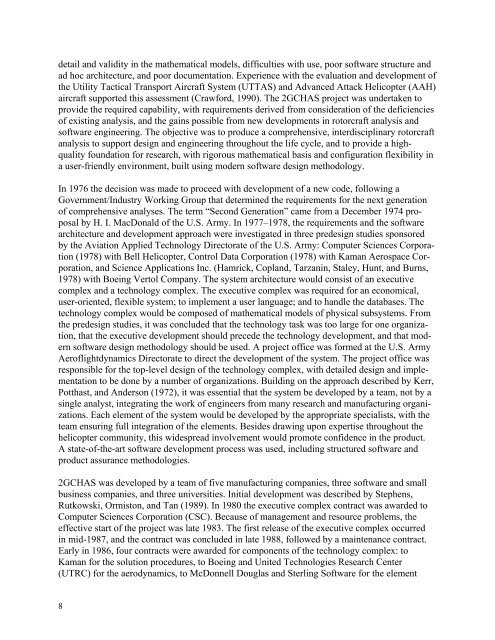A History of Rotorcraft Comprehensive Analyses
A History of Rotorcraft Comprehensive Analyses
A History of Rotorcraft Comprehensive Analyses
Create successful ePaper yourself
Turn your PDF publications into a flip-book with our unique Google optimized e-Paper software.
detail and validity in the mathematical models, difficulties with use, poor s<strong>of</strong>tware structure and<br />
ad hoc architecture, and poor documentation. Experience with the evaluation and development <strong>of</strong><br />
the Utility Tactical Transport Aircraft System (UTTAS) and Advanced Attack Helicopter (AAH)<br />
aircraft supported this assessment (Crawford, 1990). The 2GCHAS project was undertaken to<br />
provide the required capability, with requirements derived from consideration <strong>of</strong> the deficiencies<br />
<strong>of</strong> existing analysis, and the gains possible from new developments in rotorcraft analysis and<br />
s<strong>of</strong>tware engineering. The objective was to produce a comprehensive, interdisciplinary rotorcraft<br />
analysis to support design and engineering throughout the life cycle, and to provide a highquality<br />
foundation for research, with rigorous mathematical basis and configuration flexibility in<br />
a user-friendly environment, built using modern s<strong>of</strong>tware design methodology.<br />
In 1976 the decision was made to proceed with development <strong>of</strong> a new code, following a<br />
Government/Industry Working Group that determined the requirements for the next generation<br />
<strong>of</strong> comprehensive analyses. The term Second Generation came from a December 1974 proposal<br />
by H. I. MacDonald <strong>of</strong> the U.S. Army. In 1977 1978, the requirements and the s<strong>of</strong>tware<br />
architecture and development approach were investigated in three predesign studies sponsored<br />
by the Aviation Applied Technology Directorate <strong>of</strong> the U.S. Army: Computer Sciences Corporation<br />
(1978) with Bell Helicopter, Control Data Corporation (1978) with Kaman Aerospace Corporation,<br />
and Science Applications Inc. (Hamrick, Copland, Tarzanin, Staley, Hunt, and Burns,<br />
1978) with Boeing Vertol Company. The system architecture would consist <strong>of</strong> an executive<br />
complex and a technology complex. The executive complex was required for an economical,<br />
user-oriented, flexible system; to implement a user language; and to handle the databases. The<br />
technology complex would be composed <strong>of</strong> mathematical models <strong>of</strong> physical subsystems. From<br />
the predesign studies, it was concluded that the technology task was too large for one organization,<br />
that the executive development should precede the technology development, and that modern<br />
s<strong>of</strong>tware design methodology should be used. A project <strong>of</strong>fice was formed at the U.S. Army<br />
Aer<strong>of</strong>lightdynamics Directorate to direct the development <strong>of</strong> the system. The project <strong>of</strong>fice was<br />
responsible for the top-level design <strong>of</strong> the technology complex, with detailed design and implementation<br />
to be done by a number <strong>of</strong> organizations. Building on the approach described by Kerr,<br />
Potthast, and Anderson (1972), it was essential that the system be developed by a team, not by a<br />
single analyst, integrating the work <strong>of</strong> engineers from many research and manufacturing organizations.<br />
Each element <strong>of</strong> the system would be developed by the appropriate specialists, with the<br />
team ensuring full integration <strong>of</strong> the elements. Besides drawing upon expertise throughout the<br />
helicopter community, this widespread involvement would promote confidence in the product.<br />
A state-<strong>of</strong>-the-art s<strong>of</strong>tware development process was used, including structured s<strong>of</strong>tware and<br />
product assurance methodologies.<br />
2GCHAS was developed by a team <strong>of</strong> five manufacturing companies, three s<strong>of</strong>tware and small<br />
business companies, and three universities. Initial development was described by Stephens,<br />
Rutkowski, Ormiston, and Tan (1989). In 1980 the executive complex contract was awarded to<br />
Computer Sciences Corporation (CSC). Because <strong>of</strong> management and resource problems, the<br />
effective start <strong>of</strong> the project was late 1983. The first release <strong>of</strong> the executive complex occurred<br />
in mid-1987, and the contract was concluded in late 1988, followed by a maintenance contract.<br />
Early in 1986, four contracts were awarded for components <strong>of</strong> the technology complex: to<br />
Kaman for the solution procedures, to Boeing and United Technologies Research Center<br />
(UTRC) for the aerodynamics, to McDonnell Douglas and Sterling S<strong>of</strong>tware for the element<br />
8
















